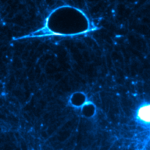Lien vers Pubmed [PMID] – 34576292
Lien DOI – 10.3390/ijms221810129
Int J Mol Sci 2021 Sep; 22(18):
The cytotoxic necrotizing factor 1 (CNF1) toxin from uropathogenic Escherichia coli constitutively activates Rho GTPases by catalyzing the deamidation of a critical glutamine residue located in the switch II (SWII). In crystallographic structures of the CNF1 catalytic domain (CNF1CD), surface-exposed P768 and P968 peptidyl-prolyl imide bonds (X-Pro) adopt an unusual cis conformation. Here, we show that mutation of each proline residue into glycine abrogates CNF1CD in vitro deamidase activity, while mutant forms of CNF1 remain functional on RhoA in cells. Using molecular dynamics simulations coupled to protein-peptide docking, we highlight the long-distance impact of peptidyl-prolyl cis-trans isomerization on the network of interactions between the loops bordering the entrance of the catalytic cleft. The energetically favorable isomerization of P768 compared with P968, induces an enlargement of loop L1 that fosters the invasion of CNF1CD catalytic cleft by a peptide encompassing SWII of RhoA. The connection of the P968 cis isomer to the catalytic cysteine C866 via a ladder of stacking interactions is alleviated along the cis-trans isomerization. Finally, the cis-trans conversion of P768 favors a switch of the thiol side chain of C866 from a resting to an active orientation. The long-distance impact of peptidyl-prolyl cis-trans isomerizations is expected to have implications for target modification.





